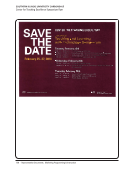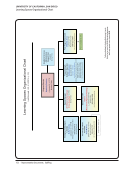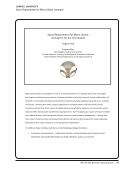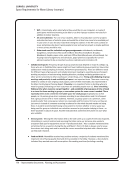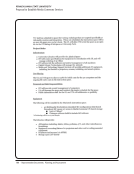82 · Survey Results: Survey Questions and Responses
Libraries, we have found that a successful reuse of what was previously a traditional collection or instruction space has
led to a more energized use of the core collection as well as a more congenial space for research development.
As collections continue to move off-site and online, the library’s physical spaces must be re-imagined as flexible,
collaborative, learning environments that measurably contribute to student success and faculty productivity.
Basically, the role is to meet the 21st century learning needs of students, to be flexible, adaptable, with appropriate
technology and/or connectivity. Providing active learning classroom environments, with fluid spaces, flowing out of
formal learning spaces and into small group collaboration spaces and individual study spaces.
Collaboration using technology that is not widely available elsewhere
Enabling students to learn about emerging technologies and to learn from each other. Providing graduate students with
both collaborative and quieter contemplative space for their intensive study and research. Providing a nexus for faculty
members in many disciplines to gather and interact.
I believe it will continue to develop as the center of interdisciplinary collaboration and as a community space. I believe
those spaces we refer to as the “commons” spaces will be less about separating groups such as faculty, graduate
students, and undergraduates and more about providing functional separation so that you can have both quiet
contemplative space and communal spaces as part of learning space.
Ideally, I would like the spaces to more seamlessly become part of the student experience as part of the curriculum, as
well as co- and extra-curricularly.
Laboratories for student work and crossroads for intellectual engagement
Learning spaces in research libraries will continue to evolve to support changes in pedagogy, student work habits,
availability of resources, including specific technological advances that change access or capacity.
Libraries have always changed to meet the needs of their users and to serve their institution’s mission, but the
importance of next-gen learning spaces in the future of research libraries will increase. One of the driving factors for this
is due to technological advances in how information can be accessed. This has led to new opportunities for libraries to
serve their constituents.
Libraries need to be more involved in the development of research assignments. We need to provide access to learning
objects that can be repurposed as needed. We need learning spaces where faculty can work with librarians and
education development experts to improve instructional effectiveness and promote the integration of information
literacy into departmental curricula on topics such as pedagogy assignment design, student centered instruction,
learning theory, learning styles, student learning assessment, and technical training. Examples would include a learning
commons that allows for the life cycle of paper writing, rooms where an intersection of faculty, librarians, and learning
specialists is encouraged. We hope to develop a visualization lab and support for multimedia labs when it ties into
library holdings (of every format). Learning happens on multiple platforms 24/7, we need to ensure the library is there—
and this includes developing better, more intuitive online resources. Currently, most webpages and tutorials are kludgy
and unsophisticated. We need to partner with our teaching colleagues and develop content for flipped, online, face-to-
face learning. Space is well beyond physical in the future.
Libraries need to be responsive to the changing needs of our students/users. A key element in the design of our
Knowledge Commons was non-weight bearing walls and raised floors. This will allow us to reconfigure the space in 5 to
10 years in response to the needs at that time.
Longer term develop active learning spaces in which any university member can create multi-media content singly
or collaboratively.
Libraries, we have found that a successful reuse of what was previously a traditional collection or instruction space has
led to a more energized use of the core collection as well as a more congenial space for research development.
As collections continue to move off-site and online, the library’s physical spaces must be re-imagined as flexible,
collaborative, learning environments that measurably contribute to student success and faculty productivity.
Basically, the role is to meet the 21st century learning needs of students, to be flexible, adaptable, with appropriate
technology and/or connectivity. Providing active learning classroom environments, with fluid spaces, flowing out of
formal learning spaces and into small group collaboration spaces and individual study spaces.
Collaboration using technology that is not widely available elsewhere
Enabling students to learn about emerging technologies and to learn from each other. Providing graduate students with
both collaborative and quieter contemplative space for their intensive study and research. Providing a nexus for faculty
members in many disciplines to gather and interact.
I believe it will continue to develop as the center of interdisciplinary collaboration and as a community space. I believe
those spaces we refer to as the “commons” spaces will be less about separating groups such as faculty, graduate
students, and undergraduates and more about providing functional separation so that you can have both quiet
contemplative space and communal spaces as part of learning space.
Ideally, I would like the spaces to more seamlessly become part of the student experience as part of the curriculum, as
well as co- and extra-curricularly.
Laboratories for student work and crossroads for intellectual engagement
Learning spaces in research libraries will continue to evolve to support changes in pedagogy, student work habits,
availability of resources, including specific technological advances that change access or capacity.
Libraries have always changed to meet the needs of their users and to serve their institution’s mission, but the
importance of next-gen learning spaces in the future of research libraries will increase. One of the driving factors for this
is due to technological advances in how information can be accessed. This has led to new opportunities for libraries to
serve their constituents.
Libraries need to be more involved in the development of research assignments. We need to provide access to learning
objects that can be repurposed as needed. We need learning spaces where faculty can work with librarians and
education development experts to improve instructional effectiveness and promote the integration of information
literacy into departmental curricula on topics such as pedagogy assignment design, student centered instruction,
learning theory, learning styles, student learning assessment, and technical training. Examples would include a learning
commons that allows for the life cycle of paper writing, rooms where an intersection of faculty, librarians, and learning
specialists is encouraged. We hope to develop a visualization lab and support for multimedia labs when it ties into
library holdings (of every format). Learning happens on multiple platforms 24/7, we need to ensure the library is there—
and this includes developing better, more intuitive online resources. Currently, most webpages and tutorials are kludgy
and unsophisticated. We need to partner with our teaching colleagues and develop content for flipped, online, face-to-
face learning. Space is well beyond physical in the future.
Libraries need to be responsive to the changing needs of our students/users. A key element in the design of our
Knowledge Commons was non-weight bearing walls and raised floors. This will allow us to reconfigure the space in 5 to
10 years in response to the needs at that time.
Longer term develop active learning spaces in which any university member can create multi-media content singly
or collaboratively.










































































































































